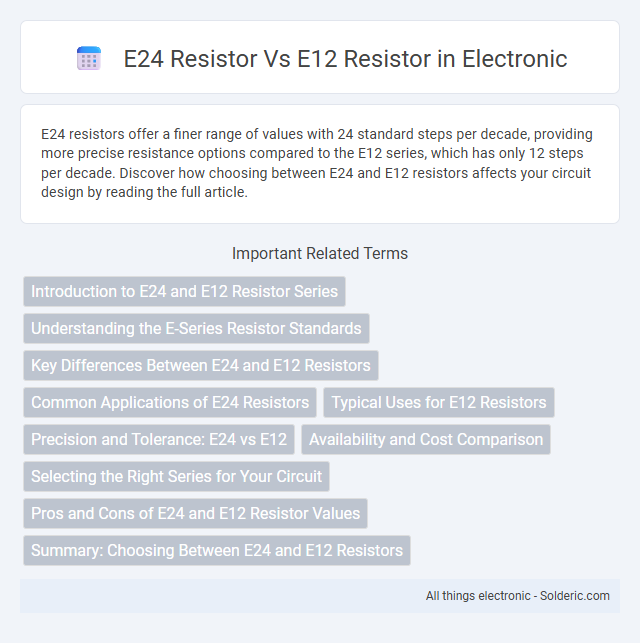E24 resistors offer a finer range of values with 24 standard steps per decade, providing more precise resistance options compared to the E12 series, which has only 12 steps per decade. Discover how choosing between E24 and E12 resistors affects your circuit design by reading the full article.
Comparison Table
| Feature | E24 Resistor | E12 Resistor |
|---|---|---|
| Number of Values per Decade | 24 | 12 |
| Tolerance | +-5% | +-10% |
| Value Steps | Smaller, finer increments | Larger increments |
| Applications | Precision circuits, fine tuning | General purpose, less critical circuits |
| Availability | Widely available, standard in precision designs | Common, easiest to source |
| Example Values (Ohms) | 1.0, 1.1, 1.2, ... up to 9.1 | 1.0, 1.2, 1.5, ... up to 8.2 |
Introduction to E24 and E12 Resistor Series
E24 and E12 resistor series differ primarily in their tolerance and available values, with E24 offering 24 standard values per decade and E12 providing 12, making E24 suitable for applications requiring finer resistance increments. E24 resistors are typically associated with a +-5% tolerance, whereas E12 resistors usually have a +-10% tolerance, affecting precision in electronic circuits. Your choice between E24 and E12 resistors impacts the accuracy and flexibility of voltage and current control in circuit design.
Understanding the E-Series Resistor Standards
E24 resistor series consists of 24 standard values per decade, providing finer granularity and more precise resistance options compared to the E12 series, which has only 12 values per decade. These resistor standards are part of the IEC 60063, defining preferred number series for electronic components to ensure interoperability and design consistency. Choosing between E24 and E12 affects your circuit design by balancing component availability, cost, and the required tolerance for accurate resistance values.
Key Differences Between E24 and E12 Resistors
E24 resistors have 24 standard values per decade, offering finer resistance increments compared to the 12 values in E12 resistors, which results in enhanced precision for electronic circuit design. E12 resistors typically have tolerance levels of +-10%, while E24 resistors usually provide tighter tolerances around +-5%, improving accuracy and performance. The broader range of values in E24 series supports more exact filtering and biasing applications, making them ideal for complex or high-precision circuits.
Common Applications of E24 Resistors
E24 resistors, with 24 standard values per decade, offer finer resistance increments than E12 resistors, making them ideal for precision electronic circuits such as analog signal processing, audio equipment, and sensor calibration. Their closer tolerance supports applications requiring accurate voltage division and current regulation, where small resistance variations can impact performance. Your designs benefit from E24 resistors when precise resistance values improve signal integrity and reduce component variation.
Typical Uses for E12 Resistors
E12 resistors, featuring a 10% tolerance and 12 standard values per decade, are commonly used in general-purpose electronic circuits where precision is not critical. They are ideal for applications like voltage dividers, biasing transistors, and simple filtering tasks where cost-effectiveness and availability are prioritized over tight tolerance. Their widespread use in consumer electronics and prototyping makes them a standard choice for hobbyists and basic electronic designs.
Precision and Tolerance: E24 vs E12
E24 resistors offer a finer precision with 24 standard values per decade, resulting in a tighter tolerance typically around +-5%, compared to E12 resistors which have 12 values per decade and usually a broader tolerance of +-10%. This increased granularity in E24 series allows Your circuit designs to achieve more accurate resistance values and improved performance in sensitive electronic applications. Choosing between E24 and E12 depends on the precision requirements of the project, with E24 preferred for tighter tolerance needs.
Availability and Cost Comparison
E24 resistors offer a wider range of values with 24 standard steps per decade, making them more readily available for precise electronic applications compared to the more limited 12 steps of E12 resistors. E12 resistors tend to be more cost-effective due to their common usage and simpler production process, which leads to lower prices in bulk. When selecting components for your project, balancing the availability of specific resistance values with budget constraints is essential for optimal cost-efficiency.
Selecting the Right Series for Your Circuit
Choosing between E24 and E12 resistor series depends on the precision and availability needed for your circuit design. E24 resistors offer 24 values per decade, providing finer granularity for accurate resistance selection, ideal for precision applications and tight tolerance requirements. E12 resistors, with 12 values per decade, suit general-purpose circuits where cost-efficiency and standard tolerance levels are sufficient, balancing performance and practicality.
Pros and Cons of E24 and E12 Resistor Values
E24 resistors offer finer granularity with 24 standard values per decade, allowing for more precise resistance tuning and better performance in sensitive circuits, but they may be harder to source and slightly more expensive than E12 resistors. E12 resistors, which feature 12 values per decade, provide simplicity and easier inventory management, making them suitable for general-purpose applications where exact resistance values are less critical. Your choice depends on whether precision or convenience takes precedence in your electronic design.
Summary: Choosing Between E24 and E12 Resistors
E24 resistors offer 24 standard values per decade, providing finer granularity and more precise resistance selection compared to the 12 values available in E12 resistors. This increased range enables designers to achieve tighter tolerance in electrical circuits, improving performance in sensitive applications. Selecting between E24 and E12 depends on the balance of precision requirements and inventory complexity, with E24 favored for high-accuracy needs and E12 suitable for general-purpose use.
E24 resistor vs E12 resistor Infographic

 solderic.com
solderic.com